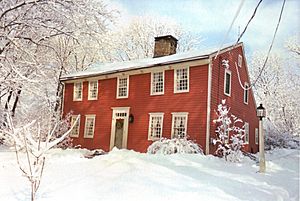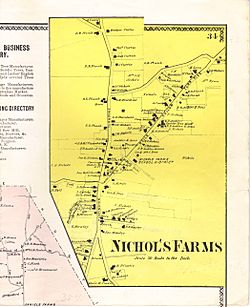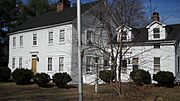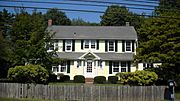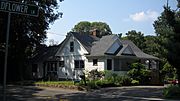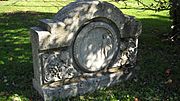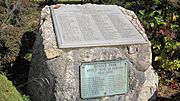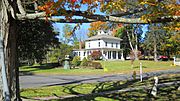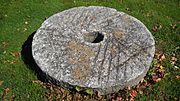Nichols, Connecticut facts for kids
Nichols is a historic village located in the southwestern part of Trumbull, Connecticut. It is in Fairfield County, Connecticut, in the United States. The village is named after a family who owned a large farm in its center for nearly 300 years. A part of the village, called the Nichols Farms Historic District, is listed on the National Register of Historic Places. This means it is a special place recognized for its history.
Long ago, the Golden Hill Paugussett Indian Nation lived in this area. English settlers arrived during the Great Migration in the 1630s. They made Nichols part of the coastal town of Stratford, Connecticut. In 1939, the Merritt Parkway was built through the village. This led to stores and factories closing. Nichols then became a bedroom community, where people live but travel elsewhere for work. A famous aviation pioneer, Igor Sikorsky, lived in Nichols from 1928 to 1951. During this time, he designed and built airplanes. He also made the helicopter for mass production for the first time.
Contents
Golden Hill Paugussett Indian Nation
The Golden Hill Paugussett Indian Nation is a Native American tribe recognized by the state of Connecticut. They are descendants of the Paugussett Nation, who lived in much of western Connecticut before Europeans arrived. While Connecticut recognizes them, the United States federal government does not.
The tribe has a 106-acre (0.43 km2) reservation in Colchester, Connecticut. They also have a very small 1⁄4-acre (0.0010 km2) reservation in Nichols. This small reservation is thought to be the oldest continuously used reservation in Connecticut. It is also the smallest in the entire United States.
History of Nichols Village
Early records of English settlement in Stratford were lost in 1650. So, we don't have many details from that time. In 1661, leaders in Stratford allowed people to claim land for farming. This land could not be within two miles (3 km) of the town meeting house. People could not build homes there without permission.
Elder Phillip Groves, Captain William Curtiss, and Lt. Joseph Judson were early landowners in Nichols. They were chosen to plan how the land would be used. Before 1661, people could farm anywhere in the township. The shared land in Nichols Farms was divided and given to individuals starting in 1670. This process continued until 1800.
Farming in Early Nichols
Mischa Hill is right in the middle of Nichols. This area was first called Misha Hill or Lt. Joseph Judson's Farm in old land records. It was the first part of Trumbull to be settled. This was because it already had clear fields for planting. It also had rich soil, ponds fed by springs, and meadows. Plus, it was only three miles from the main village.
Lt. Joseph Judson, Sgt. Jeremiah Judson, and John Curtiss started farms on Mischa Hill before 1658. In that year, they were elected as freemen by the government of the Connecticut Colony. To be a freeman back then, a person had to own land in their own name.
Other early landowners included Benjamin Beach, William Beardsley, and Richard Booth. Also, Zachariah Bostick, John Brinsmaid, and John Curtiss were early settlers. The Curtiss family had many members there: Benjamin, Joseph, Captain William, Ebenezer, and Zachariah Curtiss. Other families included Joseph Fairchild, Elder Philip Groves, Joseph Hawley (Captain), Samuel Hawley, and Ephraim Hawley. John Hurd, Lt. Joseph Judson, Jeremiah Judson, Isaac Judson, Isaac Nichols, Caleb Nichols, Abraham Nichols, Samuel Uffoot, and Reverend Zachariah Walker also owned land.
Religious Differences
In the 1660s, Lt. Joseph Judson disagreed with most of the town's elders. He and others wanted to introduce the half way covenant. This was a new religious idea. In 1671, Judson got permission from Governor John Winthrop, Jr. to move. He and other families started a new town called Woodbury.
Judson and the other founders of Woodbury either sold, gave away, or left their farms in Nichols. In 1688, John Curtiss moved to Woodbury. He gave his entire farm on Mischa Hill to his son Benjamin. Benjamin had married Joseph Judson's daughter. After Judson and others left their farms in Nichols in 1673, the area was often called Old Farm or Judson's Farm in the Stratford land records.
The Nichols Family and Their Farm
Some people say that Abraham Nichols was the first Englishman to settle in Trumbull around 1690 or 1700. It is said that others soon followed him to build mills, churches, and schools. Nichols' land was believed to be as much as 3,000 acres (12 km2). However, public land records do not fully support these claims.
According to Walter Nicholls, who wrote a book about the Nichols family in 1909, Abraham did not go with his father to Woodbury in 1673. Instead, he stayed in Trumbull to look after the farm. But Abraham was only eleven years old in 1673 (he was born in 1662). So, it's more likely he moved to Woodbury with his family. He probably returned to Trumbull as an adult between 1696 and 1700. Public land records show that Nichols owned 285 acres (1.15 km2) of land. He bought this land between 1696 and 1700. About 55 acres (0.22 km2) of it is still open space today.
The last Nichols family member to live on the farm was Florence. She married George Woods in 1903. After they passed away in 1973 and 1972, the property was given to the Nichols Methodist Church. This was Florence and George Woods' wish. The Town of Trumbull bought the land from the church in 1974. This area was then known as the Woods Estate. Today, it is home to the Trumbull Historical Society.
How Nichols Developed
Nichols is named after the family who kept a large farm in its center for almost 300 years. In May 1725, farmers in the northwest part of Stratford asked the Colony of Connecticut to form their own village. The farmers wanted to name their new Parish "Nichol's Farms." The government approved their new village in October 1725. However, they named the new parish Unity.
Unity became part of North Stratford in 1744. This happened when it joined with the parish of Long Hill, Trumbull, which was founded in 1740. When it officially became a town in 1797, the Nichols village became a school and taxing district within the Town of Trumbull.
Nichols Green
The Nichols Green or N.I.A. Green is a special park area. It is owned and cared for by a private group called the Nichols Improvement Association. This group was started in 1889 to make the village more beautiful and better.
- A monument to residents who fought in World Wars I and II is on the south end of the green.
- An 80-foot-tall pine flagpole was put up on the green in 1932. This pole came all the way from Washington state through the Panama Canal. It replaced an older 115-foot chestnut flagpole put up on July 4, 1892. That old pole carried a 25-by-15-foot flag. Some believed it was the highest flag flown in the state at that time.
- Another important spot near the green is the Bunny Fountain. The Peet family gave this fountain to the people of Nichols in 1895. It was first placed where Huntington Turnpike and Shelton Road meet. In 1931, it was moved to the Turnpike and Unity Road. In the spring of 1971, it was fixed up and moved to where it is now. It was fixed again in 1992.
- An old grinding stone from the 1826 Fairchild (Paper) Mill is at the south end of the green. This mill was located at the Falls of the Pequonnock River starting in 1674. That area is now called Fairchild Park and marks the town boundary with Bridgeport.
- A piece of the original 1940 Merritt Parkway bridge is also on the green. This bridge was built over Huntington Turnpike. The concrete piece looks like the official seal of the town of Trumbull. The bridge was taken down in 1979 when the road intersection was updated.
Pinewood Lake
Pinewood Lake was once called Pine Brook Country Club. It is famous for being the summer practice place for the Group Theatre from New York City. This theater group was started in 1931 by Harold Clurman, Cheryl Crawford, and Lee Strasberg. They wanted to create plays that would make people think about social issues.
The Group Theatre was made up of actors, directors, playwrights, and producers. They met in the countryside every summer during the 1930s, a time known as the Great Depression. They spent the summer of 1936 at Pinewood Lake. During this time, they created plays by important American writers. Their focus on realistic plays changed theater and movies forever.
Nichols Avenue
The road that connects Nichols village to Stratford center is three miles (5 km) long. It was first called the Farm Highway. Today, it is known as Nichols Avenue or (Route 108). This historic road was planned or surveyed to the south side of Mischa Hill in Nichols on December 7, 1696. The highway was described as being finished to the south side of Mischa Hill and at Zachariah Curtiss, his land, and at Captain's Farm.
In October 1725, when the Connecticut Colony approved the Parish of Unity, they called the Farm Highway Nickol's Farm's Road. The Nichols Avenue part of Route 108 in Trumbull is the third-oldest documented highway in Connecticut. The Mohegan Road, Connecticut Route 32 in Norwich (1670), and the King's Highway, or Boston Post Road Route 1 (1673), are older.
Merritt Parkway
The Merritt Parkway was built right through the middle of Nichols in the late 1930s. This construction caused a house and the old Nichols Store to be torn down. Trinity Church was also moved a few hundred feet to the north. A large natural stepping stone, 5 by 6 feet, was the only thing saved from the old Nichols Store. It was moved to the front of the Ephraim Hawley House.
In 1979, the original Huntington Turnpike Overpass was taken down. A new bridge was built in its place when the road intersection was updated. When the first 1940 overpass was demolished, its cast-iron decorations were saved. These decorations looked like a trellis with a grapevine. They were fixed up and placed as decorative items on the new Huntington Turnpike Underpass. The new bridge is not listed on the NRHP.
Famous People from Nichols
- Dick Allen (1939-2017), an American poet and a former poet laureate of Connecticut.
- James Beebe (1717–1785), a Reverend in Unity Parish from 1747 to 1785. He was also an Army Preacher in the French and Indian War and a patriot during the American Revolution.
- Truman Bradley (1826–1900), a Native American from the Schaghticoke tribe.
- Will Geer (1902–78), a famous actor and folklorist.
- Robert Hawley (1729–1799), a Captain in the local militia during the American Revolutionary War.
- Carolyn Hax (born 1966), a writer and columnist for The Washington Post. She writes the advice column "Tell Me About It."
- Joseph Judson (1619-1690), an early settler, military officer, and elected official. He helped negotiate the Long Hill Purchase from the Paugussett Indians.
- Igor Sikorsky (1889–1972), a pioneer in aviation and the inventor of the helicopter.
Images for kids
-
Igor Sikorsky's home from 1928 to 1934.
-
Igor Sikorsky's home from 1945 to 1948.
-
Igor Sikorsky's home from 1948 to 1951.


